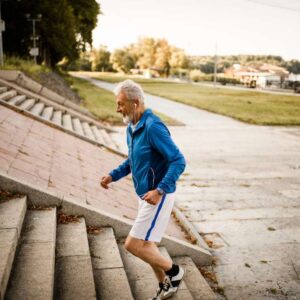
Evaluate Your Health with Five “Living Room” Tests
You don’t need a medical degree or expensive equipment to get a snapshot of your health.
In fact, there are five simple tests you can do right now from the comfort of your own living room (or neighborhood) that will give you valuable insights into your overall fitness and well-being.
Let’s take a look at what those are…
Regardless of whether you feel fantastic or a bit off your game today, it can be hard to judge your own state of overall health.
Regular check-ups with your doctor can help. But what about when you’re between appointments?
It turns out there are some easy-to-do “at home” tests that can give you a good snapshot of your health and fitness at any given time.
- Waist-to-Height Ratio: Your waistline reveals more than you might think. Your waist-to-height ratio is a simple yet powerful indicator of overall health and potential risk for conditions like heart disease and diabetes.
How to measure…
- Stand straight and measure your waist at the narrowest point, usually just above your belly button.
- Divide this number by your height.
- The goal? Keep this ratio below 0.5. For example, if you’re 70 inches tall and your waist is 33 inches, your ratio would be 0.47 (33 ÷ 70 = 0.47), which is in the healthy range.
- Resting Heart Rate: Your resting heart rate offers clues about your cardiovascular fitness and overall health.
How to measure:
- Sit quietly for 5 minutes.
- Find your pulse on your wrist or neck.
- Count the beats for 30 seconds and multiply by 2.
An average adult’s resting heart rate ranges from 60 to 100 beats per minute. Generally, a lower resting heart rate indicates better cardiovascular fitness.
- Grip Strength: Grip strength is surprisingly informative for judging overall health and longevity. While a professional dynamometer gives the most accurate results, you can get a good estimate at home.
How to measure:
- Use a bathroom scale.
- Hold the scale in both hands at chest level.
- Squeeze as hard as you can.
- The reading on the scale is your grip strength.
While norms vary by age and gender, a grip strength above 125 lbs. for men and 79 lbs. for women is generally considered good. Having trouble picturing it? Here’s a good video with more details. You can also purchase an affordable home dynamometer online from retailers like Amazon or Walmart.
- Six-Minute Walk Test: This test measures your aerobic capacity and endurance.
How to perform:
- Find a long, flat walking surface like a walking path or track.
- Walk as far as you can in six minutes at a brisk but comfortable pace.
- Measure the distance.
A healthy adult should be able to walk between 1,300 to 2,300 feet in six minutes. Less than this might indicate reduced fitness levels. A lot depends on your age, height, and sex. You’ll find a calculator here.
- Balance Test: Good balance is crucial for preventing falls and indicates overall neurological health, especially as you age.
How to perform:
- Stand barefoot on a hard surface.
- Lift one foot, bending your knee to place it against your standing leg.
- Raise your arms to shoulder height.
- Close your eyes and time how long you can hold this position.
Aim to maintain this position for at least 60 seconds. If you struggle to reach 20 seconds, it might be worth improving your balance through exercise. (Be sure to have a sturdy chair nearby or a friend to spot you to prevent an accidental fall.)
I suggest checking online for videos that will walk you through some simple balance exercises.
Remember, while these tests CAN provide valuable insights, they don’t replace regular check-ups with your healthcare provider. Use them as a starting point to monitor your health and motivate yourself to maintain or improve your fitness levels.
P.S. “Fall Proof” yourself in FOUR simple steps.
Written By Dr. Scott Olson, ND
Nearly 25 years ago, failed mainstream medical treatments left Dr. Olson in constant pain – and his health in ruins. And that’s when he did something REVOLUTIONARY. He began his career in medicine – and dedicated his life to uncovering the true, underlying causes of disease.
Through his innovative medical practices in Tennessee and Colorado, Dr. Olson has helped cure countless seniors from across America of arthritis… heart disease… diabetes… and even cancer. All without risky prescription drugs or painful surgeries.
View More Free Articles
A New Reason to Ditch Processed Junk
If you’ve ever walked the inside aisles of your local grocery store and thought, “This is all just junk,” your instincts were spot on. A new study published in the journal Thorax just added another red flag to the list of dangers linked to ultra-processed food—a 41 percent higher risk of lung cancer. That’s right....
When Being Winded on Stairs Is Serious (And When It Isn’t)
I had an athlete visit me recently because he experienced shortness of breath while climbing stairs. He is in great shape, so he was worried about what it might mean. “Doc,” he said, “I run five miles three times a week. Why am I huffing and puffing after two flights of stairs?” His concern is...
Study EXPOSES Hidden Danger Lurking in Your Car
We think of our homes and cars as safe havens. But according to a startling new study, they may be flooding your lungs with microscopic plastic particles—every single day. Researchers in France recently found that adults inhale an average of 68,000 microplastic particles daily from indoor air alone. To put that in perspective, that’s about...
Mailbag: Is Modern Food Making You Snore?
“What can cause snoring, and is there a way to correct this issue?” —Seeking Silence Hi Seeking, Snoring happens when the soft tissues in your throat relax and vibrate as air passes through during sleep. While several factors can cause snoring—from sleep position to nasal congestion—I want to share one trigger that might surprise you....
Simple Food Swap SLASHES Dementia Risk 28%
Let’s be honest… who would jump at the chance to cut their dementia risk by 28 percent. And no, you don’t need to run marathons, survive on broccoli, or learn to play the zither (whatever that is) to make it happen. All it takes is one easy swap—something that’s probably already in your refrigerator. Researchers...
This SMART Floss Exposes Hidden Health Danger
Scientists have created dental floss that doesn’t just clean between your teeth—it also tracks your stress while you’re flossing. Now, I know what you’re thinking… “Great—now even flossing is going to stress me out by telling me how stressed I am.” But this fascinating new tool from Tufts University could be a game-changer for understanding...
Is This "Safe" Sweetener Damaging Your Brain?
The headlines are alarming… “Popular Sugar Substitute Linked to Brain Cell Damage” and “Erythritol Could Damage Critical Brain Barrier” are just two of the dozens I’ve spotted recently. But before you toss every sugar-free product in your pantry, let’s take a closer look at what this study actually shows—and what it doesn’t. The latest research...
This Summer Threat Could SPIKE Your Blood Sugar
Picture this… It’s another scorching hot summer day. You crank up the air conditioning while watching the weather forecast, which predicts yet another “record-breaking” heat wave. It’s starting to feel like just another miserably uncomfortable summer. But what you might not realize is that—if you have diabetes—those rising temps could do far more damage to...
Move Over Yogurt—5 Foods That Pack MORE Probiotics
Let’s talk about your gut. The microbiome is the collection of trillions of bacteria and other tiny organisms that live in and on your body—especially in your gut—and help keep you healthy. I’ve written often about how vital it is to maintain a healthy microbiome. And you might have dutifully added yogurt to your shopping...
Is Your Heart Older Than YOU?
Maybe you feel young for your age. Good energy, decent sleep, eating your veggies. But what if I told you your heart might be a decade older than the rest of you? That’s exactly what researchers at Northwestern University found in a new study published in JAMA Cardiology. The average American woman’s heart is about...









